Unique Alpona Village of Bangladesh that is also the memorial site of Tebhaga movement leader Ila Mitra – GetBengal story
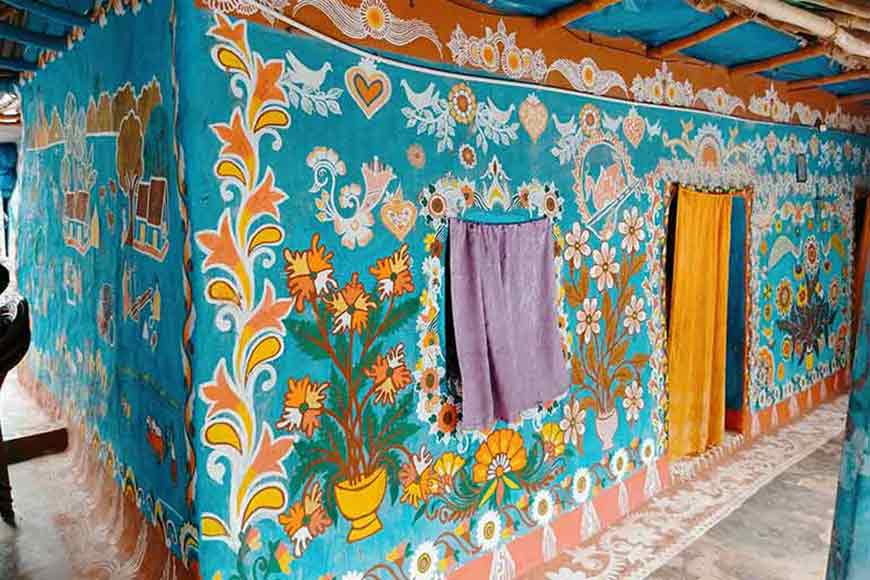
Chapai Nawabgunj, Bangladesh, is popularly known as the Alpona Village
Does Alpona speak? At times it does, specially if an entire village is decorated with one of the oldest art forms of Bengal – Alpona. Travelling and exploring different regions is like an adventure. The regions hold many such wonders which are often unknown to most. Chapai Nawabgunj in Bangladesh is popularly known as the Alpona Village where all houses have Alponas drawn on their walls. Alponas are decorative artworks, often associated with Hindu ritualistic traditions, handed down from one generation to another and is a way of expressing local values, emotions, folk stories and day-to-day lifestyle.
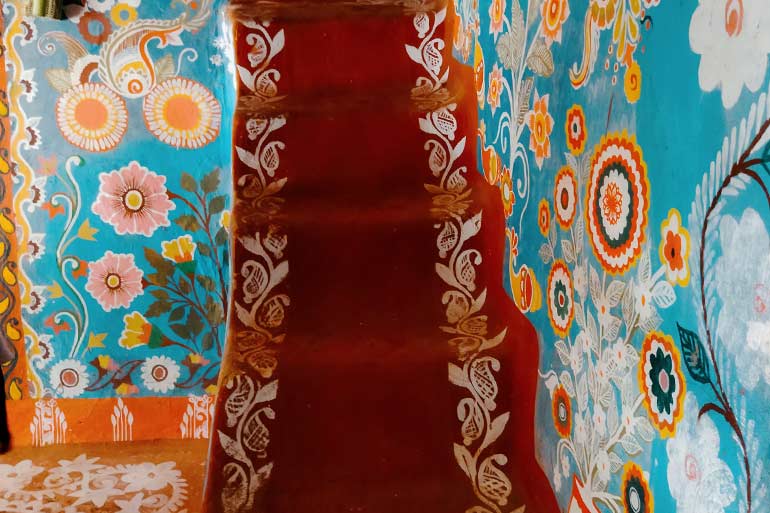
Houses of Tikoil village in Nacholupazila of Chapai Nawabgunj in Bangladesh have houses painted with Alpona. The place is the memorial site of Ila Mitra, the leader of Tebhaga movement. Locals still refer to Ila Mitra as “Rani Ma”. Nachol village is situated beside the Hat Bakoil village of Nejampur Union. More than 50 houses have been painted with different designs, paintings that depict stories. The village first caught everyone’s attention through the advertisement of Berger paints. It became famous both nationally and internationally, so much so that people from different regions of the world come to visit the place. Dasu Barman, a resident of Tikoil, has a copy in which the people who visit the “Alpona baris” are asked to write about their experience. Daykhon Barman is one of the prominent artists of the Barman household who has taught many on how to draw these motifs. She is not literate but her artistic mind and aesthetic sense has earned her a lot of respect. Most of the women of the village follow her footsteps.
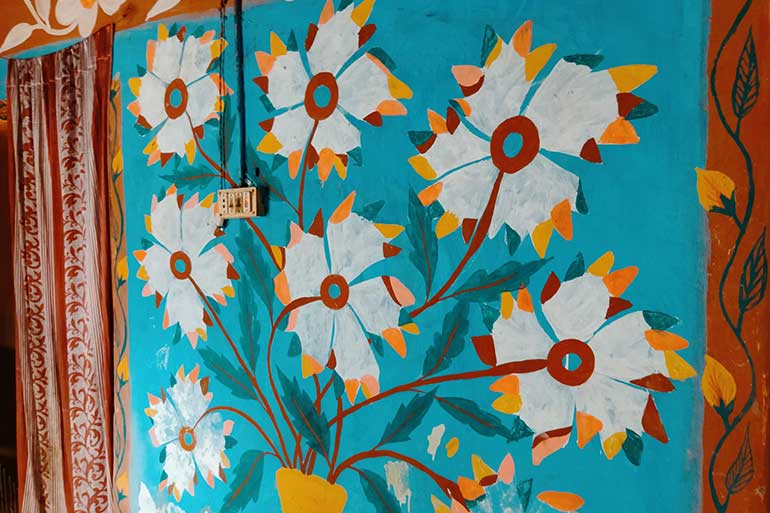
Most people of the village belong to the royal dynasty. Almost 90 families reside here. The beautiful Alponas are drawn mostly by the women of the village. Earlier the women used to draw such motifs with rice powder, flour, chalk powder, turmeric and vermilion. A paste was made after mixing all the ingredients in water. Chandan or sandalwood was also used but mainly for ritualistic purposes. Nowadays, with the increasing availability of chemical colours, many have started using such colours to make everything look more vibrant. Some paintings are done with a mixture of chalk, red ochre and turpentine oil. Nowadays, they are done by soaking a mixture of colours made from dry clay, red ochre, peel of old mango seeds, chalk powder, colours, Colocasia and bark of banana tree. The colours made out of this mixture stay longer and alponas painted with it last more than a year.
Also read : How did the Folk Art of Alpona come to Bengal?
Some paintings focus on Durga Puja and Lakshmi Puja while others deal with a variety of motifs from Hindu verses. There are also Alponas that resemble conch Shells, fish, chickens, schools, national flag, national memorials, lotuses, birds, rivers, people, flowers, farming and so on. With utmost concentration, these women paint such beautiful motifs on the walls of the entire house. They paint on not only the exterior walls of the house but interiors as well, on the Tulsi mandap, bedrooms, kitchens, lanes, balconies and almost every other corner. The stairs are also decorated. Pictures of Rabindranath Tagore, Kazi Nazrul Islam, Ila Mitra, Sheikh Mujibur Rahman and Sheikh Hasina are also drawn through Alponas. The paintings are a bit off during the monsoon season, but in winters they appear brighter.
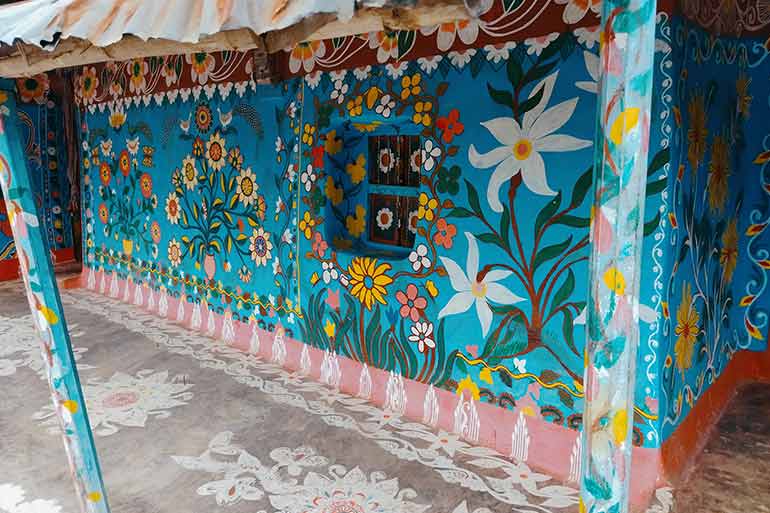 Alponas are drawn on the walls of the houses
Alponas are drawn on the walls of the houses
This unique tradition has been maintained for generations by the women of Tikoil. Even though the mud houses are decreasing in numbers as brick houses are replacing them, yet the villagers insist on continuing their tradition and keeping their industry alive. The Chapai Nawabgunj district administration has illuminated the Alpona village with solar lights. Some have been provided with relief houses, the village temple is being renovated as well, the district administration is also supportive of keeping this alpona tradition alive.
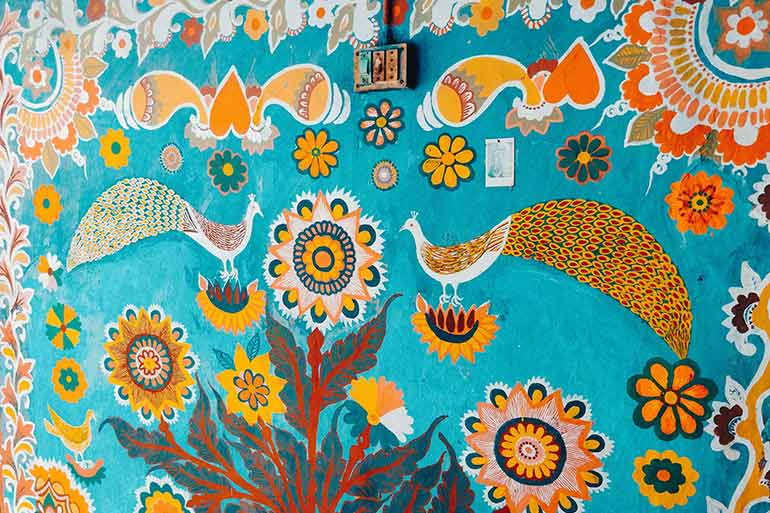
Such priceless sights are still around and these traditions should be kept alive to understand the beauty in minimalism. There are 40-storey buildings but such beauty is rooted to the earth. It connects us to the simplicity of life.











